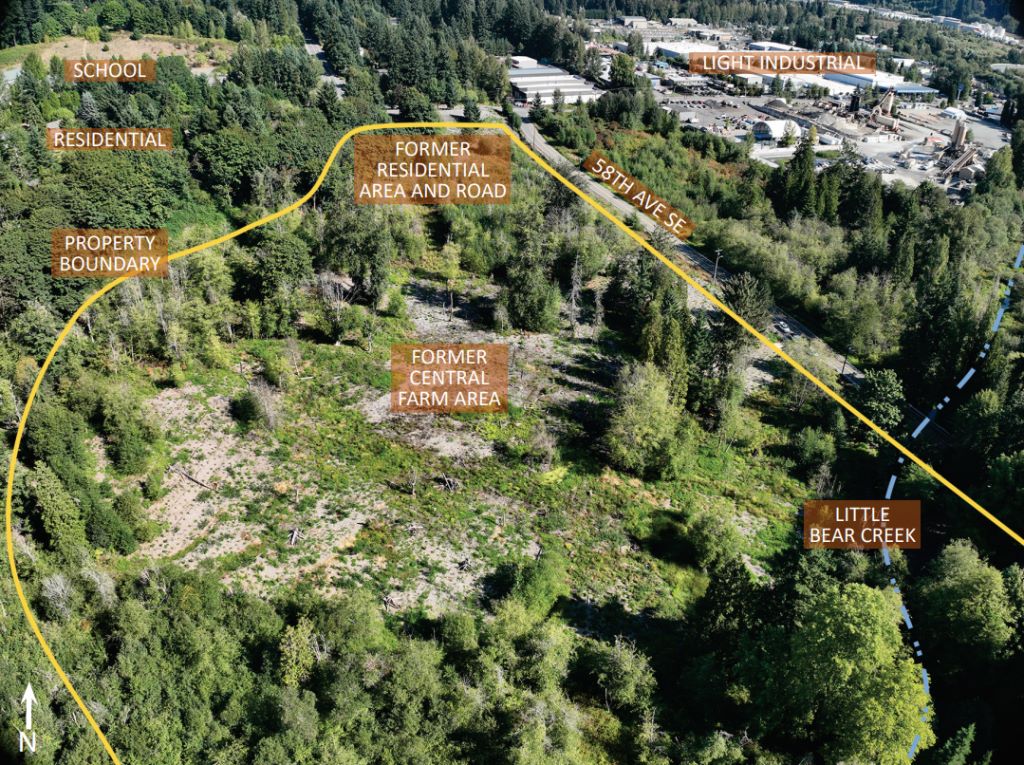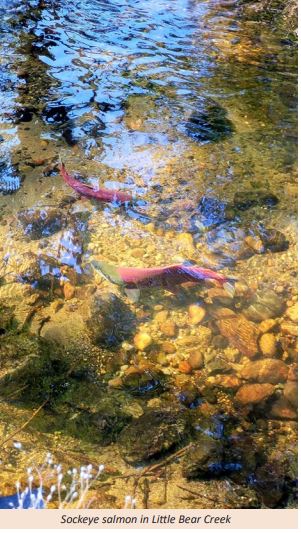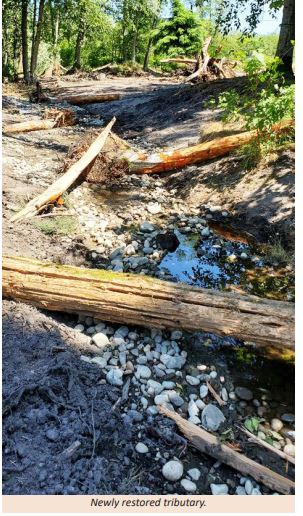SNOHOMISH COUNTY—Snohomish County Public Works is being recognized nationally for an innovative project that changes the way the County handles wetland mitigation and saves millions of dollars in future taxpayer funds. The creation of Little Bear Creek Advance Mitigation Site (LBCAMS) has been named a national 2024 Public Works Project of the Year from the American Public Works Association in the Environmental under $5 million category.

“It’s a prestigious award to have obtained and an honor to have worked on this project and represent the Snohomish County community,” Oscar Fuentes, Project Manager, told the Lynnwood Times. “It was definitely a highlight of my career and, again, very grateful to Kelly Snyder and the rest of the team for giving me the opportunity to be project manager. This project will forever remain in my heart for years to come.”

What was unique about the project is that there were a lot of upfront costs, Fuentes continued, where most county projects’ costs come towards the end of completion. For Little Bear Creek upfront costs accounted for more than 50% of the total project cost.
An additional benefit to this is Fuentes was able to work with the rest of the team to come up with four different avenues to weigh costs for the upcoming 11 different projects the mitigation site will be used for, compared the costs, and was able to show management that there would be a significant return investment.
By using all local funds, one of the tools utilized was what is termed, “forced account,” which allowed the contractor to be compensated for their efforts during the “field fitting” process. Field fitting, essentially, is the on-the-ground engineering, separate to the preliminary “in-office” engineering behind the scenes which may not be able to account for certain forces of nature.

The project was also unique in that most county projects, for example capital projects, of which most of Fuentes’ career has been spent working on, involve building infrastructure where Little Bear Creek involved removing infrastructure to restore the area back to a protected wetland.
It was extremely important to keep visionary and optimistic, Fuentes shared, in order to remain on schedule, and within budget and scope because there were various stakeholders involved.
Fuentes said out of every project he has worked on the Little Bear Creek mitigation site stands out because all the pieces just came together. That’s not to say it didn’t experience its challenges, the global pandemic for example impacted its progression as it did most things, but the team never gave up and kept at it.

This was Fuentes’ first ever project as Project Manager and he shared that the knowledge and skills learned will be invaluable for the remainder of his career.
Darla Boyer, Environmental Lead for the project, described the project as an “interconnecting, recirculating web of knowledge and people,” adding that many different aspects came together, from permits to breaching new trails in advanced mitigation—something the state of Washington has yet to fully dive deep into before now.
The process required outreach and discussions with people Public Works may have not normally come in communications with, but these different agencies banded together to move it across the finish line.


“When we use the word collaboration there’s so much behind that term we can’t describe,” Boyer told the Lynnwood Times. “Collaboration is a basket full of opportunities and just accidental path crossings — divine intervention at some points where challenges were beyond our abilities, but it worked out because we were able to come together at the right time with the right people.”
Boyer recalls standing on the side of the road the first day of the project thinking “this is the perfect mitigation site” because everything the department needed, in regard to environmental infrastructure, was already in place — albeit disturbed but able to be restored.
“Being able to visualize that site in the future, take the steps to get there, and then to get thanked for it from an award. You know you don’t except that, you’re just doing your job so to get an award for it is just really amazing,” said Boyer.
Kelly Snyder, Snohomish County Public Works Director, lives close by the site and has driven by it for the last 30 years. Every time she did the pass, she thought to herself, “what is going on with this site, it’s terrible.”

“When I came to work for the county a little over four years ago and heard about this project I was thrilled because not only is it a good idea just generically but it’s just a good idea because it’s a ecosystem, not just on the ground but also with the professionals who have made it happen,” said Snyder. “That sort of regeneration, recreation, restoration and then sort of this new way of approaching projects is just extraordinary. I think that’s what’s being acknowledged here.”
Snyder noted that Darla Boyer was the brainchild for the project for bringing the idea to light and kept pushing, asking good questions, encouraging, and being persistent.
Boyer is set to retire from the county in the coming months, making this project much more special. Reflecting upon her career she shared with the Lynnwood Times that her time with the county has been a series of “building blocks,” beginning her career knowing little in the realm of science but, by virtue of the county’s robust training and mentorships, eventually became one of the leading experts in environmental mitigation.

If Boyer had to choose her all-time favorite achievement from her tenure it would be the Little Bear Creek mitigation site, not only because it will be the last big project she will work on before retirement but because she considers it her “swan song” because everything she has learned, and everything she has worked on during her career, culminated into it.
“I’m in my best place when I’m helping others so I’m usually behind the scenes but to actually get this really cool project to be the last one I work on for the county, and have it recognized, is just really special,” said Boyer.
Throughout Boyer’s career she has worked on everything from estuary restoration; to coastal, stream, and wetland restoration in the private, public, and tribal sectors. Now that she’s retiring, she looking forward to focusing more on the life she said she put on hold to focus on her career – namely discovering a new part of who she is and building a community around her through volunteer work.
The 17-acre project is now a protected wetland mitigation site that allows the County to be proactive in addressing mitigation requirements by generating wetland credits for future project impacts. Consolidating wetland restoration and enhancement efforts in advance is expected to save the County more than $30 million on 11 county road projects, when compared to building concurrent wetland mitigation projects or purchasing wetland credits from a mitigation bank.

Developing LBCAMS started in 2017 when the County purchased a derelict property built on wetland fill in the densely populated southern part of the county. Returning the site to a high-functioning forested wetland involved removing 17 structures, 4.25 acres of wetland fill, 1,200 feet of drainpipe and electrical conduit, and more than 37,000 square feet of impervious surface, and adding 6,300 cubic yards of compost and wood chip mulch and more than 21,000 native plants. The total project cost was $4.2 million.
The Stillaguamish Tribe of Indians, SCJ Alliance and Reece Construction were also honored at the national level by the APWA for Project of the Year in the Transportation $5 million – $25 million category for their 236th St NE corridor improvements. As the owner and partnering agency, Snohomish County Public Works was proud to nominate this worthy project for the award and congratulates our community partner.
APWA’s annual awards recognize infrastructure projects that are publicly owned and promote excellence in construction, management, and administration. These awards recognize the alliance between the managing agency, the contractor, the consultant, and their cooperative achievements for the good of their communities. Both Snohomish County projects were previously recognized as projects of the year in their respective categories at the state level by the Washington Chapter of APWA.
Snohomish County Public Works last won a national project of the year award in 2010 for the replacement of Sauk River Bridge 414. Other previous national award-winning projects include the replacement of South Slough Bridge 91 in 2008 and the Puget Park Drive extension in 2007.
Supplemental Information
- American Public Works Association (APWA) 2024 Project of the Year Award for the Environmental <$5 Million. View the award presentation.
Author: Kienan Briscoe









